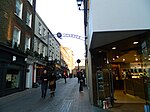The Cat's Whisker
Coffeehouses and cafés in the United KingdomMusic venues in LondonSoho, London

The Cat's Whisker was a coffee bar situated at 1 Kingly Street, Soho, London, during the mid-late 1950s. It offered London youngsters Spanish dancing, live rock 'n roll, and skiffle.It saw the invention of a new style of 'dancing' known as hand-jive, dancing using hand gestures only as there was no space to maneuver in the crowded basement. The venue was closed in 1958, owing to overcrowding.
Excerpt from the Wikipedia article The Cat's Whisker (License: CC BY-SA 3.0, Authors, Images).The Cat's Whisker
Kingly Street, City of Westminster Soho
Geographical coordinates (GPS) Address Phone number Website Nearby Places Show on map
Geographical coordinates (GPS)
| Latitude | Longitude |
|---|---|
| N 51.512083333333 ° | E -0.13861111111111 ° |
Address
Two Floors
Kingly Street 3
W1F 7PA City of Westminster, Soho
England, United Kingdom
Open on Google Maps






